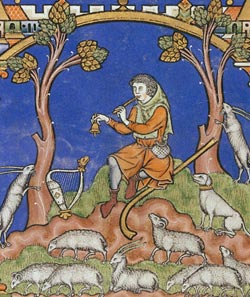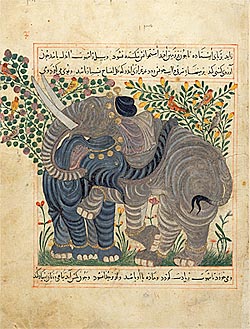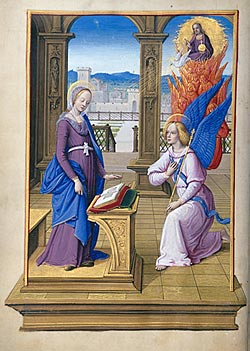When Pierpont Morgan acquired his first medieval manuscripts at the end of the nineteenth century, he laid the foundation for a collection whose quality would rank among the greatest in the world. Since Morgan's death, the collection has more than doubled and now comprises about 1,360 items.

The Young David, Morgan Crusader Bible.
Paris, France, ca. 1244-1254. MS M.638, fol. 25v
Although the collection was formed to illustrate the history of manuscript illumination and includes significant masterpieces from the ninth to sixteenth centuries, there are also some important textual manuscripts as well as a group of papyri.
The Morgans Collect
Pierpont Morgan's first six manuscripts were purchased with James Toovey's collection of bindings and books in June 1899. A month later, Morgan's nephew Junius Spencer Morgan informed him about the availability of the celebrated Lindau Gospels, which in early 1901 became the cornerstone of the collection. In the same year, also at Junius's suggestion, Morgan purchased the library of Theodore Irwin. In 1902 he made his most important bulk purchase, the impressive collection of 110 illuminated manuscripts assembled by Richard Bennett, which included twenty-nine manuscripts that had belonged to William Morris.
A turning point for the collection came in 1905, when Pierpont Morgan hired Belle da Costa Greene as his librarian. Her role in shaping and developing the collection over a period of forty-three years cannot be overestimated. She advised Morgan on purchases; by the time of his death in March 1913, the manuscripts in the collection numbered 630. Through her recommendations and the active interest of J. P. Morgan, Jr., additions continued to be made based on their artistic merit or their scholarly or textual importance. The Morgan collections made possible the rise and development of manuscript studies in the United States.
Schools and Periods
The collection is made up primarily of Western manuscripts, with French being the largest single national group, followed by Italian, English, German, and Belgian. The collection also has significant examples of Armenian, Syriac, Coptic, Ethiopian, Arabic, and Persian manuscripts. More than fifty Coptic manuscripts found in Hamouli, Egypt, nearly all of which are in their original bindings, form the oldest and most important group of Sahidic manuscripts from a single provenance, the Monastery of St. Michael at Sôpehes.
Apart from the earlier papyri, the collection ranges from the fifth century to the Renaissance. For the earlier periods, many of the most important monastic centers are represented, such as those at Reims, Tours, Canterbury, and Salzburg.

Two Elephants, Abu Sa'id 'Ubayd-Allah ibn Ibrahim, known as Ibn Bakhtishu, Manafi al-Hayawan Uses of Animals). Maragha, Persia, 1290s. MS M.500, fol. 13
The majority of these books are of a religious nature, but the collection also includes important works of the classical authors, scientific manuscripts dealing with astronomy and medicine, and practical works on agriculture, hunting, and warfare. Although the collection is known principally for its illuminated manuscripts, it also includes significant unilluminated manuscripts, such as the earliest surviving portion of the letters of Pliny the Younger (Rome, late fifth century) and the earliest surviving witness to the Fables of Phaedrus (France, ninth century). Medieval music is represented mostly by liturgical books, such as Antiphonaries, Graduals, and Hymnals, but also includes seven troubadour songs with music by the celebrated Martín Codax.
The Library also possesses a small but choice collection of Islamic and Indian manuscripts and single miniatures. Pierpont Morgan acquired only about twenty of these, but later additions brought the total to about 130. Belle Greene's personal collection of manuscripts, bequeathed to the Library in 1950, was almost entirely Islamic.
Manuscript Series
The collection is organized into six manuscript series or subcollections.
Morgan manuscripts (MS M.1-MS M.1122): All manuscripts acquired by Pierpont Morgan and his son (MS M.1-MS M.691) belong to this series, which also includes subsequent acquisitions not otherwise designated. The Morgan series contains many of the Library's greatest treasures, such as the Lindau Gospels (MS M.1), the Life of St. Edmund (MS M.736), the Berthold Sacramentary (MS M.710), Old Testament Miniatures (MS M.638), the Hours of Catherine of Cleves (MS M.917 and MS M.945), and the Farnese Hours (MS M.69).
The other five series consist of collections that were given to the Library. Each series is designated by the first letter of the donor's surname.
Glazier manuscripts (MS G.1-MS G.75): The Glazier series consists of the collection of illuminated manuscripts formed by William S. Glazier (1907-1962). Placed in the custody of the Library in 1963, it became the Library's property outright in 1984. The collection, which was then the finest private collection of medieval and Renaissance manuscripts assembled in this country since the days of Pierpont Morgan and his son, covers a thousand years, from the fifth to the sixteenth century; two-thirds of the manuscripts date before 1400. The collection includes such exceptional volumes as the earliest Coptic Acts of the Apostles (MS G.67), the Chelles Sacramentary (MS G.57), the Salzburg Lectionary (MS G.44), the Hachette Psalter (MS G.25), and the finest illustrated manuscript of Der Wälsche Gast (MS G.54).

Jean Poyet, Annunciation, Hours of Henry VIII. Tours, France, ca. 1500. MS H.8, fol. 30v
Heineman manuscripts (MS H.1-MS H.9): The Heineman series contains manuscripts from the Dannie and Hettie Heineman collection. Dannie N. Heineman (1872-1962) began to collect books and manuscripts about 1905, and continued to do so until his death. Although the collection is especially strong in French and German literature of the eighteenth and nineteenth centuries as well as in musical manuscripts, two of the illuminated manuscripts are of exceptional importance: a Pontifical illuminated by Attavante for Pope Leo X in 1521 (MS H.6), and the so-called Hours of Henry VIII, a masterpiece illuminated by Jean Poyet (MS H.8). The collection, put on deposit at the Library after Dannie Heineman's death, was given to the Library in 1977.
Bühler manuscripts (MS B.1-MS B.61): Among the many volumes bequeathed to the Library by Dr. Curt F. Bühler (1905-1985) was his collection of sixty-one medieval and Renaissance manuscripts. Dr. Bühler, who worked in the department of Printed Books for fifty-two years, serving for many of them as its Keeper of Printed Books, was one of the world's leading authorities on the art and history of books printed during the fifteenth century. The manuscripts reflect his research interests, which were textual rather than art historical; consequently, they add another dimension to the Library's holdings. Especially intriguing is a late-fifteenth-century Neapolitan cookbook (MS B.19).
Stillman manuscripts (MS S.1-MS S.21): E. Clark Stillman (1907-1995), a longtime friend of the Library, made a promised gift of his private library of books and manuscripts in 1992. They were placed on deposit in 1993 and bequeathed in 1995. Many of the twenty-one manuscripts in the collection reflect Mr. Stillman's devotion to the Low Countries and their art.
Wightman manuscripts (MS W.1-MS W.73): The extraordinary library of fine bindings, children's books, and illustrated books bequeathed to the Library in 1994 by Julia Parker Wightman (1909-1994) also contained fifty-nine manuscripts. They joined the fourteen manuscripts given to the Library in 1993 by Miss Wightman. More than half the manuscripts are Islamic or Indian, greatly strengthening this area of the Library's holdings. The collection also contains Books of Hours, documents, and some Ethiopian manuscripts.
Papyri
In 1912 Morgan acquired the collections of Egyptian, Coptic, and Greek papyri assembled by Lord Amherst of Hackney. The collection includes the Ascension of Isaiah and other biblical and early church fragments as well as classical documents from the Ptolemaic, Roman, and Byzantine eras. The Library also has on deposit most of the papyri found at Nessana by the Colt Archaeological Institute in 1937.
CORSAIR, the Morgan's online collection catalog, is available here.
